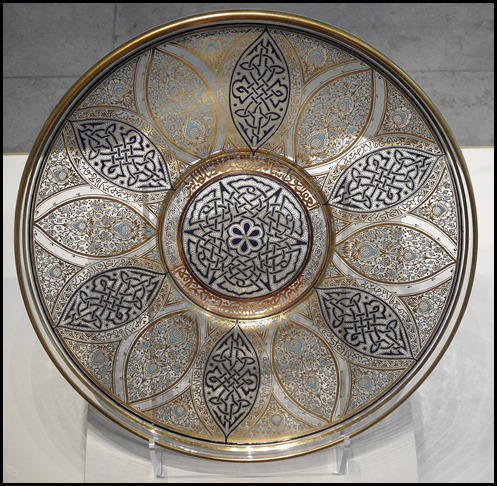IAMM Bits & Bobs

|
IAMM Bits & Bobs that
Caught Our Eye
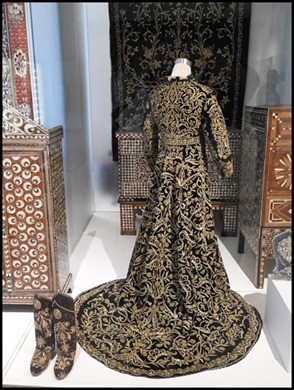 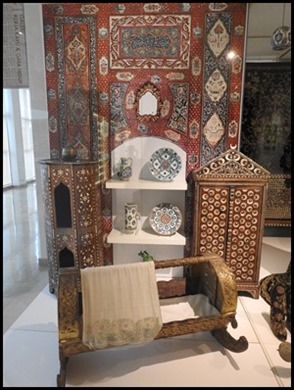 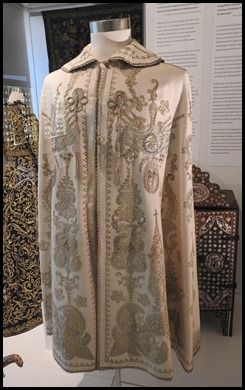 Such a massive collection cannot be
given justice in a blog, so here are some bits and bobs that, for us, stood out.
Embroidered Velvet Robe. Turkey. 19th century. Crib and beautiful wall unit. Circa 1900. Embroidered Wool Cape. Ottoman Empire. Circa 1900.
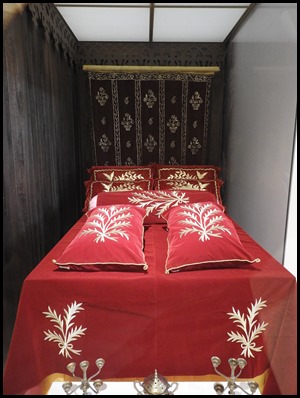  Palace bridal
suite.
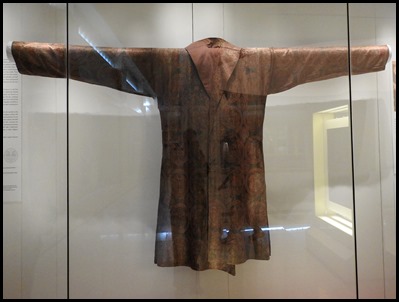  Silk Lampas Robe.
Sogdiana, Central Asia. 7th – 8th century
AD.
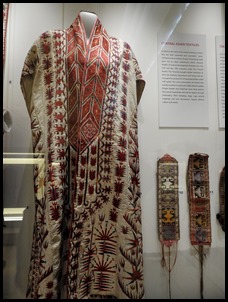  Located at the heart of the Asian
landmass, Central Asia has both separated and connected great civilisations for
hundreds of years. Flourishing trade gave rise to urban settlements, which
reached heights of cultural development between the mid 14th and late 16th
centuries, under the Timurid Empire. The Timurids brought skilled craftsmen to
cities like Bukhara, Samarkand and Herat, and encouraged the production of
exquisite textiles under craft guilds. The rural communities of Central Asia
equally excelled in textile arts. Tribes like the Uzbek, Khirgiz, Kazakh and
Turkoman have long expressed their proud equestrian and warrior legacy through
embroidery. Their hangings, bags, rugs, animal
trappings and tent decorations feature distinct colours and motifs.
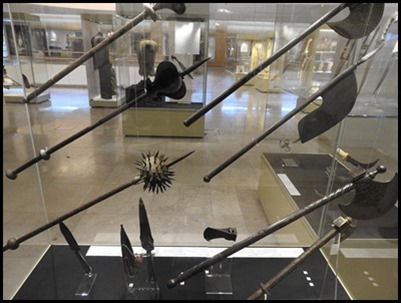  We bimbled around
the lethal weapons and bows.
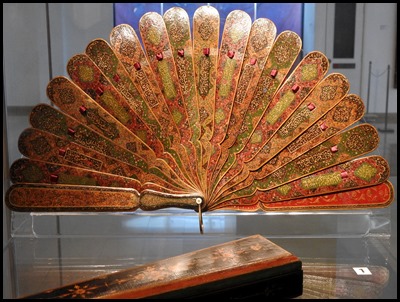  Lacquered
Papier-mache fan. Qajar, Iran. 1883 – 1884 AD (one of my
favourite items).
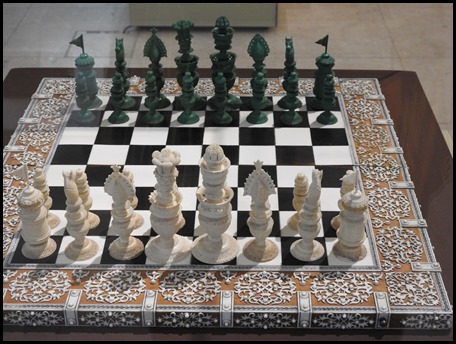 Chess Board and
Complete Set of 32 Carved Ivory Chess Pieces. India. 19th century. The
earliest references to chess are found in Persian writings from around the 6th
century AD, which use the term chatrang. The term derives from the
Sanskrit chaturanga, meaning ‘in four parts’, and refers to the four
components of an early Indian army: infantry, cavalry, elephants and chariots.
The game is believed to have travelled across the globe following the Silk Road
and become vastly popular all over the world.
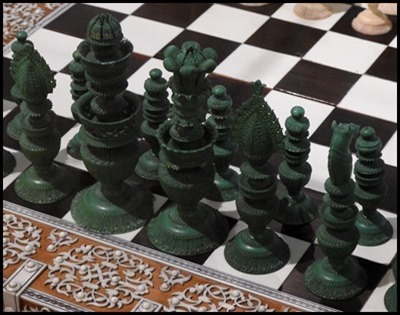  It is said that the Caliph Harun
al-Rashid carried on a chess match he was unable to finish, through
correspondence with his rival ruler, the Byzantine Emperor Nicephorus at the
turn of the 8th century AD. And in the 12th century AD, a book entitled
‘Book of Chess: Extracts from the Works of al-Adli, as-Suli’ was
compiled quoting Abbasid chess masters, al-Lajlaj and al-Suli, from the 10th
century AD.
In 1509 Diego Lopez, commander of the
first Portuguese expedition to Malacca, was recorded to be playing chess, when a
Javan from the mainland came aboard, immediately recognised the game and the two
men discussed the form of the pieces used in the chess set played
there.
Babur, the founder of the Mughal
Empire in his memoirs, characterised one of his nobles as “madly fond of chess”.
In his new capital city of Fatehpur Sikri, Babur’s grandson Akbar built a
life-sized chessboard in a courtyard and – using dancing girls and courtiers as
pieces – played from the apartments above.
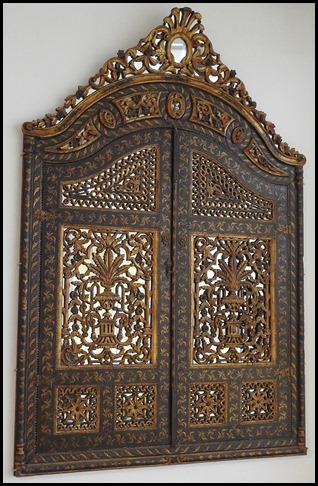 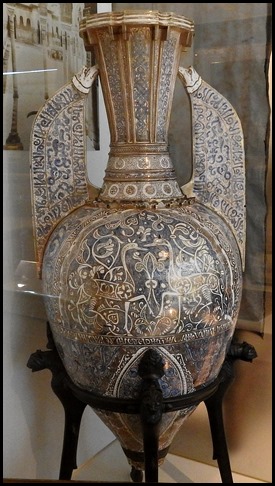 Carved wooden
window frame. Possibly Syria or Turkey. 19th century AD. Hispano-Moresque lustre vase. Spain. 19th century
AD
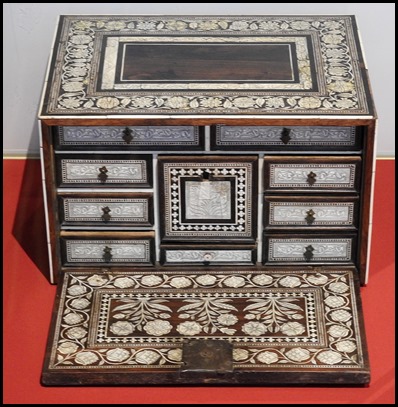 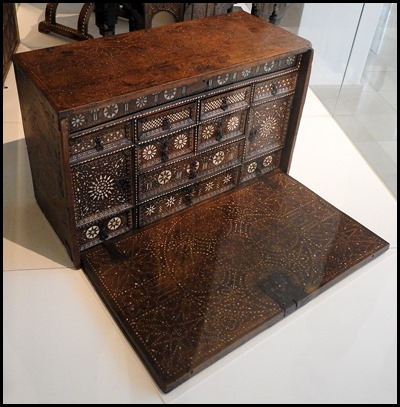 Ivory-inlaid wood
chest. India. 17th – 18th century AD. Walnut table
cabinet. Spain. 16th century AD.
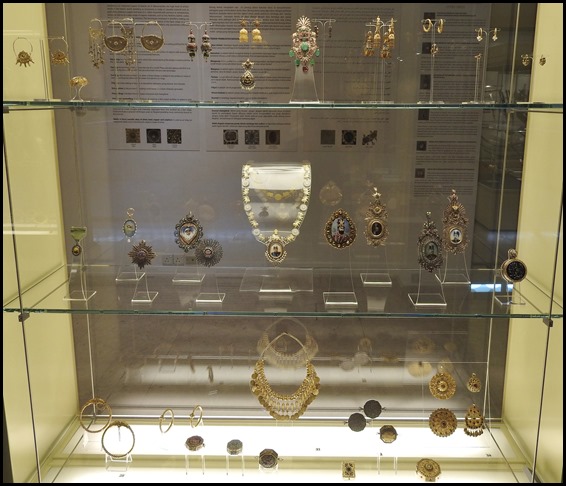 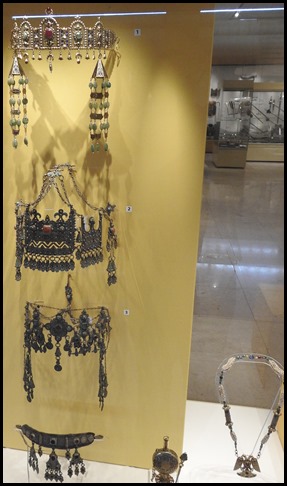 Sumptuous
jewellery.
 Necklace –
Khanti / Rantai Leher – Khanti. Enamelled gold set with diamonds. North India.
circa 1850 – 1875 AD.
In Indian royal context jewellery is
worn as both adornment and _expression_ of wealth and power. Epitomising the
Mughal aesthetic for luxury, the overall effect of this necklace is the symbol
of splendour and magnificence. Commissioned for a wealthy patron, each diamond
was cut and foil-backed so as to bring out its maximum brilliance.
The necklace is set with diamonds in
Kundan technique and polychrome luminous enamel decoration on the reverse.
Kundan jewellery has made a royal mark in India’s history. It started out in the
North, specifically in Rajasthan. Its southern counterpart was in Hyderabad. The
hanging pendant, in the form of a peacock, a symbol of beauty and grace, adds a
three-dimensional element to the design. The enamelling on the reverse is also
of the highest quality, each panel within the rosettes features painted floral
petals and leaves with finely combed details that add a sense of
palpability.
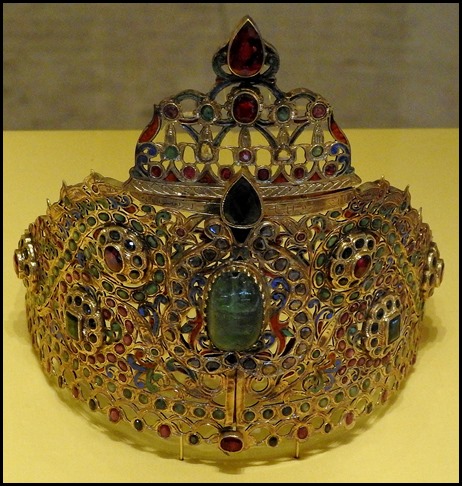 Gold
Tiara. Morocco. 1800 AD: A richly jeweled Moroccan wedding tiara. It is
decorated with emeralds and gemstones and displays a pyramidal shape facet and
open back. The gold jewellery of Morocco is often gifts associated with royalty
and noble ladies. It is inscribed with al-Izza Li’llah wa li-rasulihi
meaning honour belongs to God and His Messenger.
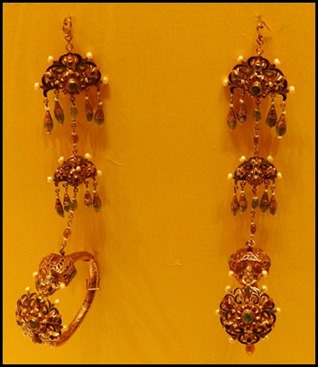 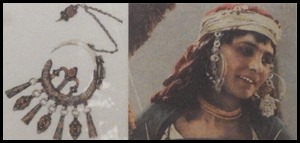 Pair of
Ceremonial Earrings. This sumptuous earrings, also known as
dewwah is most commonly found in the southern cities of Morocco
particularly in Marrakesh. The earrings are worn as part of a larger head gown
ornament. By attaching the chain onto the wearers’ head dress, the larger hoop
then loops around the front of the ear exposing the richly decorated adornment.
If they say so, to me anything but studs constitutes instruments of
torture......
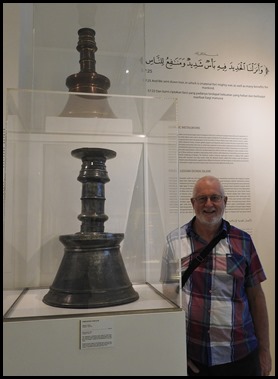  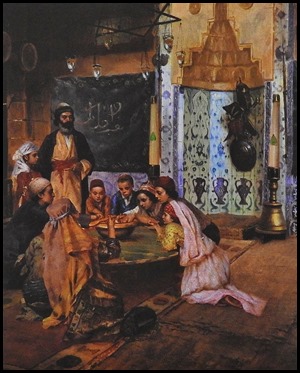 Candlestick. Ottoman
Turkey. 1768. The calligraphic cartouches reads: Waqf for Jami’ Idris. The
generous patron Hajj Ali Agha Buyuk father of Abeh Mour and Haygun, present the
candlestands in the year 1181.
Candlesticks: Among the types of
lighting used in mosques were large candlesticks. They flanked the sides of the
mihrab niche and provided light to the structure during the early hours of dawn
and during evening prayers (Ishaa). According to
travellers like Al-Qazwini (died 1283 AD) and Ibn Battuta (died 1377 AD),
centres of production for metal candlesticks became popular in Northeast
Anatolia and in the province of Fars.
In the 15th century AD, Sultan
Bayazid II commissioned two large gilt brass candlesticks for his mosque complex
in Edirne, Turkey. In the 16th century AD, Sultan Suleiman the Magnificent is
known to have bought two colossal candles from Hungary to be be placed on both
sides of the mihrab at the mosque of Aya Sofya (Hagia Sophia). Turkish painter
Osman Hamdi Bey (1842-1910) depicted candlesticks in his paintings. The
exemplify the varied use of candlesticks in Ottoman Turkey. Details of La Charite chez les derviches a
Scutari, Rudolf Ernst (Austrian, 1854-1943).
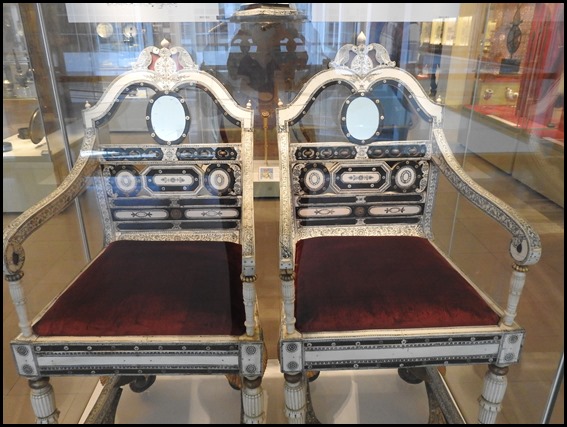 Pair of
Armchairs. Vizagapatam, India. First half 19th century AD. Veneer inlaid
with ivory and mother of pearl.
British power in India, in the 18th
century, introduced Indo-European furniture styles which was favoured not only
by Europeans but also Indian rulers and elite. European traders began exporting
Western prototypes to copy and it was soon discovered that the Indian craftsmen
were highly skilled. This skill coupled with an incredible imagination led to
the emergence of the independent Indo-European style. Vizagapatam, a port in the
north of the Eastern Coromandel Coast of India, was renowned from the late 17th
century for inlaying and veneering ivory, and soon became the centre of the
manufacture of ivory-veneered Anglo-Indian furniture. The armchairs are veneered
with ivory, engraved with flowers and leaves as well as mythical beasts and
birds. Featuring a central mirror framed with studded tortoiseshell above
various openwork rails, the back embellished with metal jewel-like cartouches.
The seat on fluted solid ivory front legs and swept forward back legs are
supported by engraved gilt brass and gold peacocks with mechanical springs that
make the wings flap when weight is applied to their backs. The association of
peacocks with thrones, however, goes back to Shah Jahan’s famous peacock throne
built in 1635. Glad to see these chairs in a museum but very pleased they cannot
be made anymore with tortoiseshell and ivory anymore.......
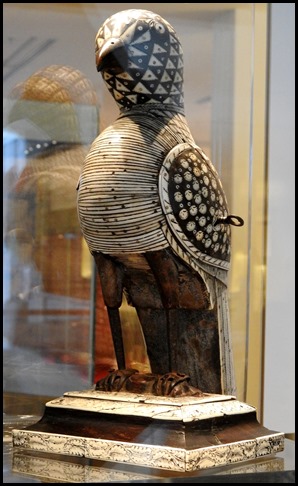 Bird-shaped
Container. Etawah, India. Circa 1882 AD. Ivory and horn parquetry, inlaid
with mother of pearl.
Geometric parquetry of mother of
pearl, ivory and horn executed during the second half of the 19th century in
Etawah, a small town in the state of Kotah, Uttar Pradesh. This type of work was
produced by two or three families belonging to the Khatri caste. Although items
or Etawah were mentioned in the exhibition catalogues of Calcutta in 1882 – 1883
and the colonial and India exhibition in London in 1886, this is the only
bird-shaped container known. The featured artefact, the bird of prey, is covered
in geometric shapes of ivory and horn with details picked out in mother of
pearl. The hinged top with locking mechanism opens to reveal one single
compartment, originally lined in metal. The bird is supported on metal legs, its
claws clutched around its prey in low relief as an integral part of the stepped
base.
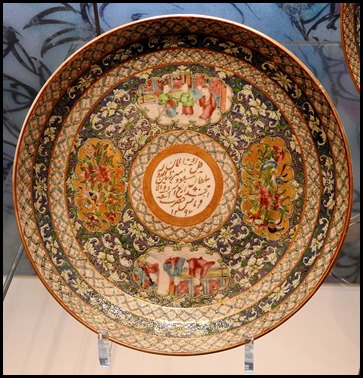 Canton famille
rose dish of Zill aI-Sultan. China. 1879 – 1880 AD.
Chinese Porcelain Exports for Qajar Royalties: Blue
Canton, Fitzhugh and other Chinese enamelled porcelains were highly prized by
the Qajar royalties. During the reign of Nasir al-Din Shah and his eldest son,
Zill al-Sultan, Chinese porcelains with the Qajar Coat of Arms; the lion, the
sun and the Kiani crown were commissioned for the royal court and as gifts from
the Shah.
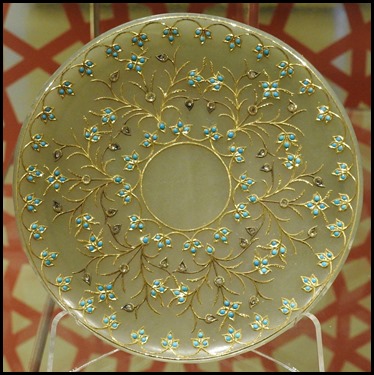  Gold-inlaid Jade
Saucer. India. Circa 1900 AD and my favourite piece of jade.
Celadon Jade Dish. Mughal, North India. 17th – 18th century
AD.
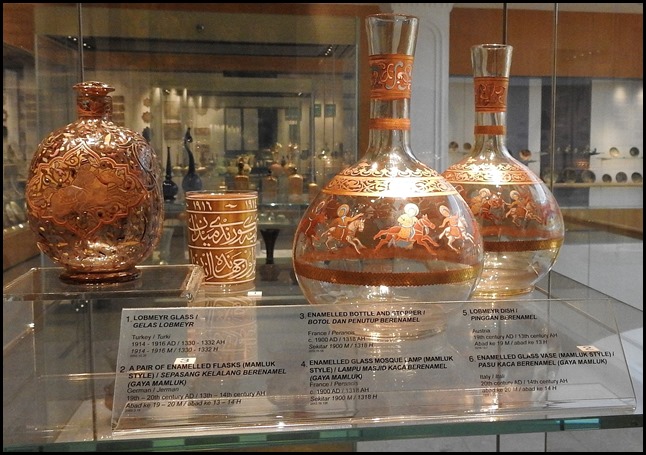 Stunning glass
collection
Islamic Glass
Development: “He set before us whatever is sweet in the mouth or fair
to the eye. He brought forth a vase, which was as though it had been congealed
of air, or condensed of sunbeam motes, or moulded of the light of the open plain
or peeled from the white pearl”. Al Hariri (1054 – 1122 AD). An excerpt from the
12th century manuscript, the Maqamat. The translucent delicacy of glass
has long made it an object of desire around the world. The earliest examples of
glass were in the form of beads dated to around 2500 BC. Tablets written in
cuneiform about glass manufacture around 1300 – 1100 BC provide evidence of the
documentation and long history of glass production.
The production and decorative
techniques of glass in the Islamic world owe a debt to its predecessors: the
Byzantine empire within Syria and Egypt, and the Sassanian empire within Iraq
and Persia.
The history of Islamic glass may generally be divided into three periods. The 8th to the 11th Century: The development of glass-cutting techniques and revival of lustre painting on glass. As both Persia and Mesopotamia had thriving industries in the pre-Islamic period, after the advent of Islam this continued uninterrupted throughout Umayyad and Abbasid lands. The 12th to the 15th Century: The development of gilding and enamelling techniques in glassware. During this period, Syria and Egypt held a monopoly on glass production, though Iran and Iraq also contributed to a lesser scale. Islamic glass was highly regarded and widely distributed in the treasuries of Europe and as far afield as China. The 16th to the 19th century: The gradual decline of the glass industry and increasing adoption of Western influences.
ALL IN ALL AN
EXQUISITE COLLECTION
REMARKABLE FOR THEIR
AGES
|
